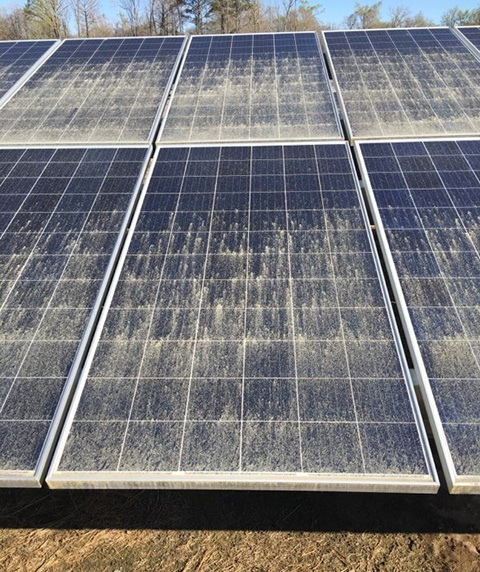NREL Research Finds Rain Not Enough To Wash Pollen From Solar Panels
Rainfall can wash away many things, but even a steady downpour may not be enough to clean pollen from solar panels. That is the conclusion of researchers who examined the effects of pollen on the performance of five utility-scale solar plants in North Carolina.

The scientists, headed by a team from the U.S. Department of Energy’s National Renewable Energy Laboratory (NREL), found the proliferation of springtime pollen that coated the solar panels reduced performance of the technology at every site. Rainfall was able to wash away some of the pollen but not enough to return photovoltaic (PV) performance levels to what they were before.
“There is still much work to do to fully understand the risks and implications of pollen and bio-soiling in the southeast U.S., but this work has made clear that regular rainfall is not sufficient to assume that solar plants are fully cleaned in certain environments,” said Matthew Muller, a research engineer within the PV Performance and Reliability group at NREL and co-author of a new paper describing the problem with pollen.
The paper, “An Investigation on the Pollen-Induced Soiling Losses in Utility-Scale PV Plants,” appears in the IEEE Journal of Photovoltaics. Other co-authors include Joao Gabriel Bessa, who visited NREL from the University of Jaen in Spain; Michael Valerino, who co-founded Solar Unsoiled; and researchers from the University of Jaen, Duke University, and Sapienza University of Rome.
Soiling, which occurs when dust, pollen, or other elements hinder light from reaching solar cells, has emerged as an ongoing problem, both in terms of PV performance and realized revenue for solar plant operators. Exactly how big a problem soiling presents depends on local conditions and climate. Previous research has estimated soiling losses in arid and semi-arid locations but not in rainier locations where pollen is a problem, such as in the southeastern United States.
Muller, who has extensively studied the soiling problem, and his colleagues measured the effects of the utility-scale solar plants located in four counties in North Carolina. Their findings ran counter to a common assumption that frequent rainfall would result in negligible soiling impacts. Instead, they determined the performance of the solar panels decreased by as much as 15% during peak pollen season, with most pollens coming from cypress, juniper, pine, and oak trees. While these are peak losses, the data suggest that without planned cleaning, annual production losses can be on the order of 10%.
The solar plants had all been operational for more than seven years at the time of the analysis, without any manual cleaning performed. Solar Unsoiled, working in conjunction with the system owner, measured performance increases from 5% to 11%, following mechanical wet brush cleaning.
The researchers noted in their paper that they had expected soiling losses would be minimal because of a relatively high average rainfall and short dry periods, but the losses were higher than expected. Even after the end of the pollen season, the performance of solar panels did not return to their previous “cleaned” levels despite frequent rains. The findings confirmed that soiling potential must be carefully examined in regions with frequent rainfall and that planned cleaning may be necessary to avoid large financial losses and system underperformance. As a result of this work, NREL and Solar Unsoiled are designing a study to further investigate the mechanisms and risks associated with pollen and bio-soiling in the southeastern United States.
Last Updated May 28, 2025
